Planning your own trip? Prepare for your trip
Use Rough Guides' trusted partners for great rates
Plan and book your private, tailor-made tour with vetted local experts
Braga is Portugal’s spiritual capital, packed with churches and cloisters that shape the city’s identity. One of the country’s oldest settlements, it began with the Iron Age Bracari tribe before the Romans took over and laid down streets, baths, and temples. Centuries of invasion and reconquest followed, but by the time Portugal became independent in the eleventh century, Braga was already a powerful bishopric.
Religion still defines the city today, from the archbishop’s vast palace to processions that dominate the calendar. Just outside the center, you’ll find Tibães, the oldest Benedictine monastery in Portugal, and the theatrical Baroque stairways of Bom Jesus do Monte, which draw pilgrims and sightseers alike. If your Porto and North Portugal tour brings you to Braga, these are the landmarks that give the city its spiritual and cultural weight.

Hey, I’m Gody, your Portugal travel expert, and Braga is one of those cities that never really sits still. Sure, it’s famous as Portugal’s religious heart, but it’s also a university town buzzing with students, cafés, and nightlife. You’ll find Roman ruins under your feet, Baroque staircases climbing into the clouds, and church bells marking the rhythm of daily life. This Braga travel guide will give you the essentials: how to get there, what not to miss, and where to stay.
Braga rewards both patience and curiosity. Walk through the arcades of Praça da República, duck into side streets for old-fashioned pastry shops, and climb the monumental stairway to Bom Jesus do Monte. The big landmarks are obvious: Sé Cathedral, the Archbishop’s Palace, and the sanctuary at Sameiro. But it’s the quieter details that linger: tiled chapels tucked into alleyways, students spilling out of late-night bars, and locals who seem to know everyone by name.
Gody’s tip
Do not rush Bom Jesus. Ride the water-powered funicular up, then walk down the staircase slowly. Each landing has chapels, fountains, and views that get better as you descend.
Best time to visit
Spring from April to June is lively, especially during Holy Week when the processions fill the streets. September and October bring warm weather and fewer crowds. July and August are hot, but evenings are lively with festivals. Winter is cooler and quieter, perfect if you want to explore the city without distractions.
How to get to Braga
Trains run hourly from Porto’s São Bento station, taking about an hour. From Lisbon, it is a 4 hour train ride with a change in Porto. Driving gives you freedom to explore the Minho region. It is about 40 minutes from Porto or 3 and a half hours from Lisbon. Buses also connect Braga with nearby towns like Guimarães and Barcelos.
Best areas to stay in Braga
Braga sits in the Minho region of northern Portugal, surrounded by vineyards and wooded hills. It is about 55 kilometers north of Porto, a forty-minute drive or an easy train ride. From Lisbon, the trip takes around three and a half hours by car or four hours by train.
Often named among the best places to visit in Portugal, Braga is both a historic city and a lively modern hub. From here, you can visit Guimarães, known as the birthplace of Portugal, sample vinho verde in Amarante, or escape into the wild trails of Peneda-Gerês National Park.


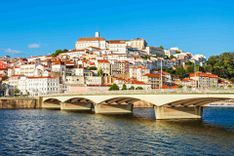
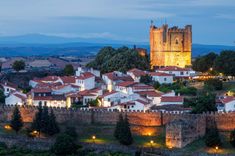

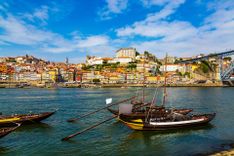










Braga is compact, walkable, and easy to explore without a car. Most of the main sights cluster around the historic center, where narrow streets lead you between churches, squares, and cafés. Public transport and taxis make it simple to reach places on the city’s edge, like Bom Jesus do Monte or Sameiro.
If you are wondering how many days in Braga are enough, one full day will cover the essentials. You can visit the Sé Cathedral, stroll through Praça da República, and take the funicular up to Bom Jesus do Monte without feeling rushed.
Stay overnight if possible. The city has a different atmosphere in the evening, when the squares fill with students and the churches glow under soft light. With two days, you can add the Sameiro Sanctuary, Tibães Monastery, and still have time to linger in Braga’s cafés and side streets.
Suppose your Portugal itinerary takes you through the north, plan at least two or three days in Braga. Spend one exploring the city center, another on Bom Jesus and Sameiro, and use the extra day for nearby trips to Guimarães, Amarante, or the Minho vineyards. Watching sunset from Bom Jesus and sunrise over the cathedral spires is worth the extra time.
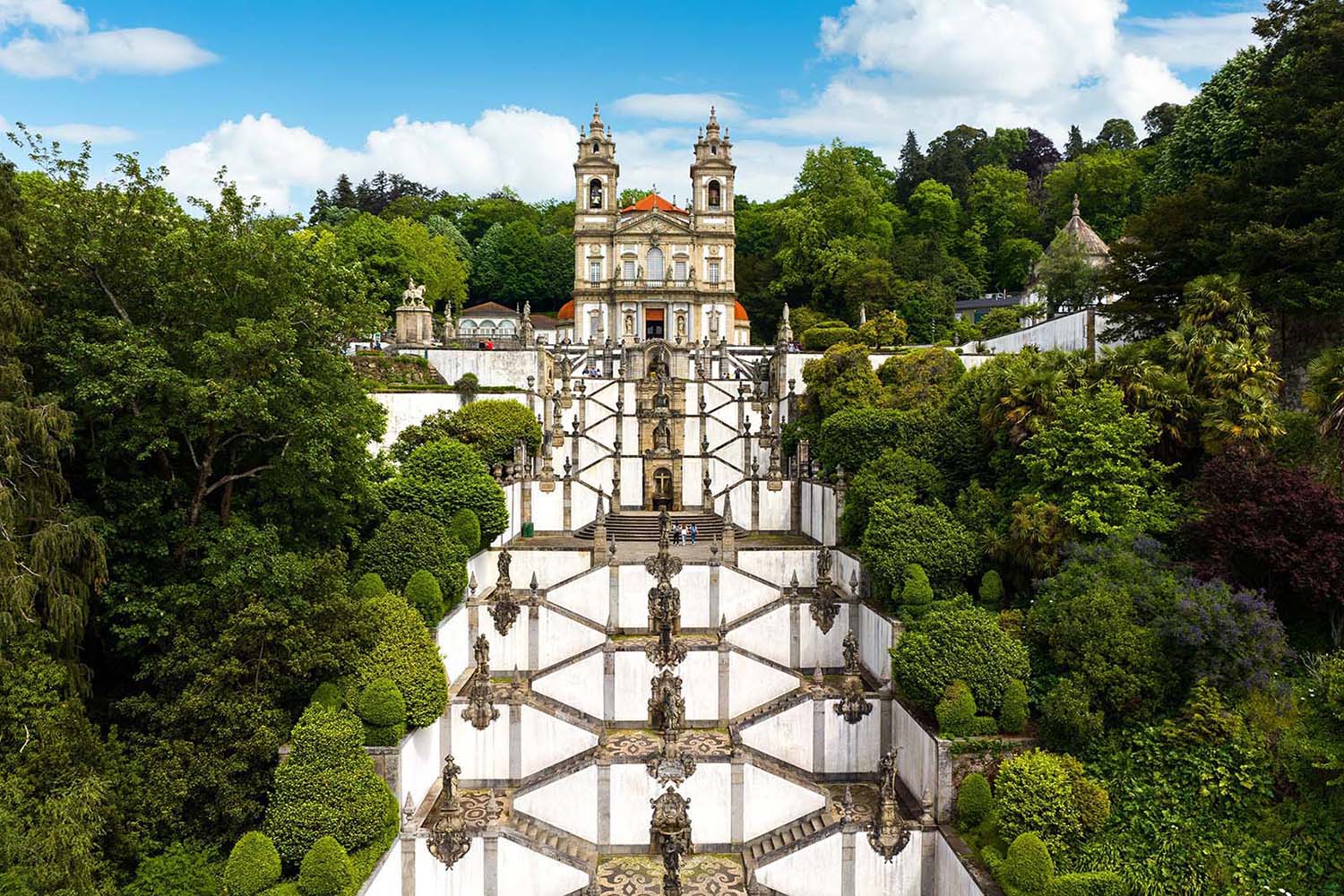
View of the Sanctuary of Bom Jesus do Monte in Braga, Portugal © Shutterstock
Braga has everything from historic guesthouses to modern hotels, with most options clustered around the old center or near the sanctuaries on the city’s edge. Here is where to base yourself depending on your style of travel.
Braga might be best known as Portugal’s religious capital, but there’s more to it than church spires. Roman ruins, student hangouts, processions that fill the streets, and hilltop sanctuaries all give the city its mix of the sacred and the everyday. You can see the highlights in a day, but spend longer and you will uncover layers that make Braga one of the most fascinating cities in the north.
Braga’s cathedral is the oldest in Portugal, and you feel the weight of history the moment you step inside. Construction began in the 12th century, but every century since has left a mark: Romanesque foundations, Gothic side chapels, Baroque altarpieces, and Manueline flourishes. The double organ, dripping in gilded woodwork, is one of the most ornate in the country, and services here still carry a grandeur that matches the setting.
Do not miss the Treasury Museum, which holds jeweled chalices and medieval vestments, or the Gothic chapels where Portugal’s first kings are buried. The cloisters are quieter, perfect for catching your breath after exploring the maze of carvings and side altars. Arrive early to avoid the tour groups, and give yourself at least an hour to take it all in.
The Baroque stairway to Bom Jesus is Braga’s showstopper. Rising 577 steps, it zigzags up the hillside in a theatrical sequence of fountains, chapels, and allegorical statues. Each landing has its theme: senses, virtues, or the life of Christ. Pilgrims have been climbing it for centuries, often on their knees, but you can take it at your own pace.
At the top, the church crowns a terrace with sweeping views over Braga and the plains beyond. The funicular, one of the oldest water-powered systems in the world, is worth a ride too, if only for the novelty. Go early morning for cool air and fewer people, or late afternoon when the low light makes the whitewashed chapels glow. Bring water: the climb is exposed and demanding in summer.
While Bom Jesus dazzles with Baroque flourishes, Sameiro is all about scale and setting. Built in the 19th century, its basilica sits even higher on the hillside, dedicated to the Virgin Mary. The marble altar and stained-glass windows are impressive, but the real drama lies outside: broad terraces that look out across the Minho. On clear days, you can see the mountains of Peneda-Gerês on the horizon.
Sameiro is quieter than Bom Jesus, so it is a good choice if you want the views without the crowds. The road linking the two sanctuaries makes a great walk or cycle, shaded by trees and lined with chapels. If you can, time your visit for the evening, when the basilica is bathed in soft light and the city twinkles below.
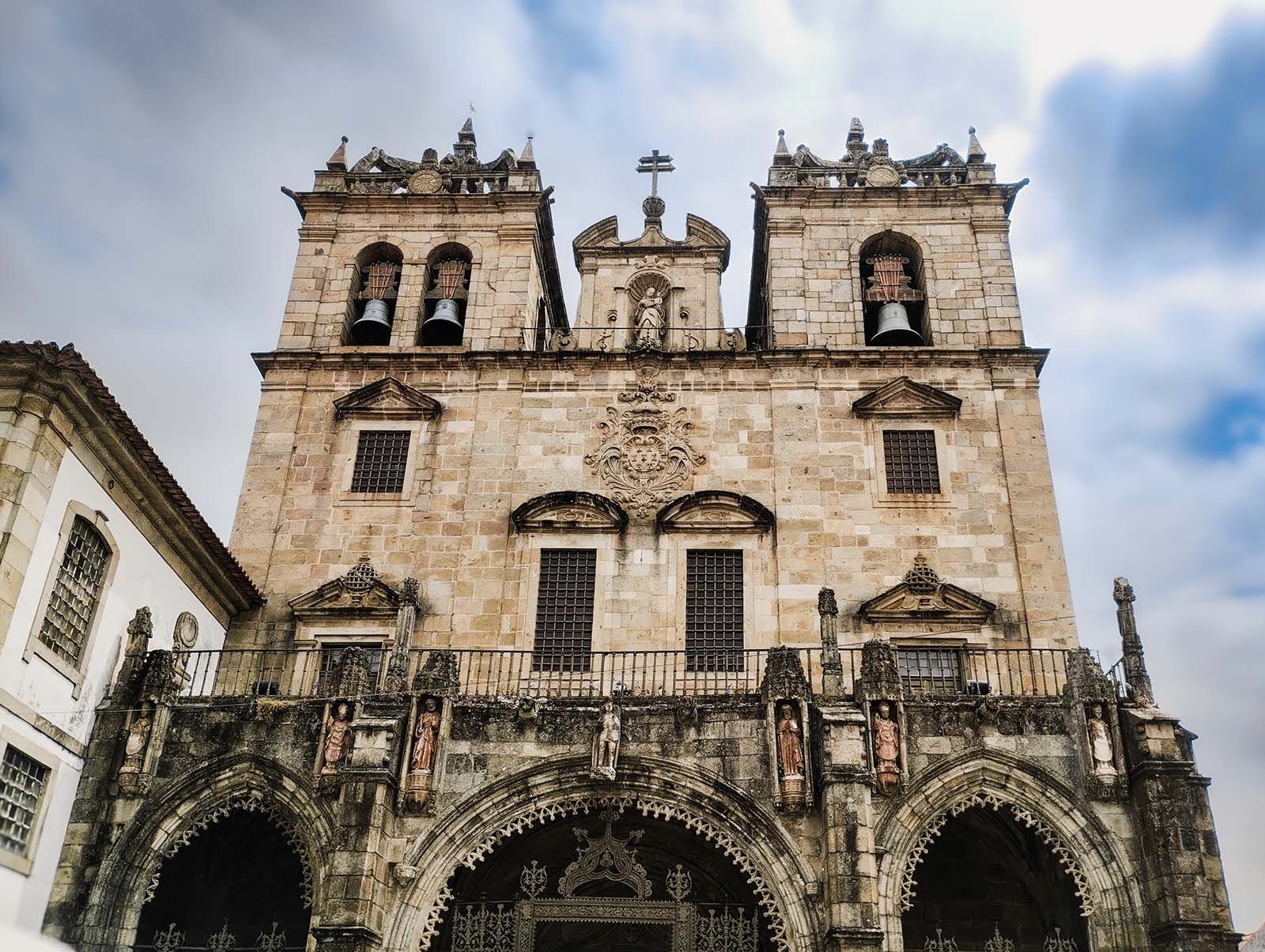
Facade of the First Cathedral Built in Portugal © Shutterstock
Locals call it Arcada, after the arcades that run along one side, and it is the beating heart of Braga. This is where you stop for a coffee at Café Vianna, watch students drift between classes, or just people-watch by the central fountain. On warm days, the outdoor terraces fill up with chatter, giving you a taste of Braga’s younger, more modern side.
The square links directly into pedestrian streets lined with tiled facades, bakeries, and small shops. Walk a few minutes and you will find Largo do Paço, framed by the Archbishop’s Palace, or Jardim de Santa Bárbara, a neat flower garden with a ruined Gothic wing as its backdrop. Come in the evening when the lights reflect off the fountains, and the atmosphere is at its best.
This museum feels like stepping into another era. The 18th-century palace once belonged to a noble family, and many rooms are still furnished as they were: painted ceilings, carved furniture, and tiled floors that creak underfoot. Alongside the aristocratic interiors, you will find archaeological finds from Braga’s Roman past, including mosaics and ceramics.
The highlight is the baroque garden, hidden away behind high walls. Fountains gurgle under orange trees, statues peek out of clipped hedges, and tiled stairways lead to shaded corners. It is one of the most peaceful places in the city, especially in spring when the flowers are out. If you want a break from churches and squares, this is where to take it.
Just a short bus ride from the center, Tibães was the mother house of the Benedictine order in Portugal. At its height, the monastery controlled vast swathes of land, and the scale of the complex reflects that power. Inside the church, the gilded altarpieces glitter with over-the-top baroque carving, while the cloisters and chapter house are designed for quiet reflection.
The grounds stretch out into farmland and woodland trails, so you can combine a cultural visit with a short walk. Few tourists make it here compared to Bom Jesus, which makes Tibães feel more authentic and atmospheric. Plan a couple of hours to explore properly, and bring a picnic if the weather is good.
You could spend days hopping between Braga’s churches and still not see them all. Santa Cruz is worth it for its over-the-top baroque facade, carved so intricately it looks almost alive. Misericórdia Church has Renaissance lines and a calmer interior. Even small chapels tucked into side streets have elaborate tiles and gilding that rival bigger cities.
What makes them special is how active they still are. You are just as likely to walk into a service as you are to find an empty nave. Light a candle, sit quietly for a few minutes, and you will see why Braga’s religious reputation is more than just history.
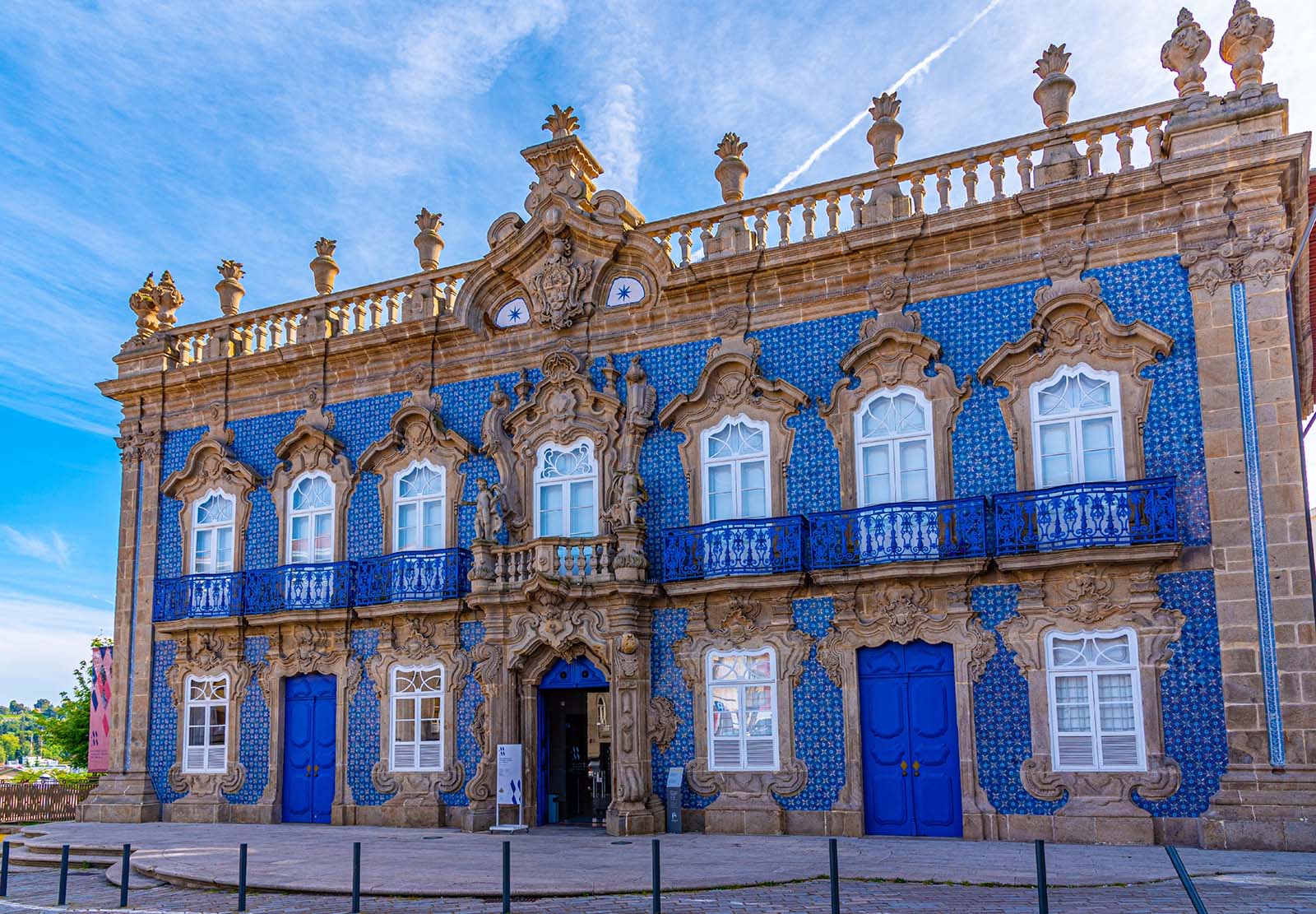
Palacio do Raio in Braga, Portugal © Shutterstock
Braga’s Semana Santa is one of the biggest religious festivals in Portugal, and it transforms the city each spring. Processions of hooded brotherhoods carrying torches move slowly through the streets, accompanied by the sound of drums and brass bands. Balconies are draped in red and purple cloth, and thousands of people crowd into the squares.
Even if you are not religious, the atmosphere is unforgettable. Hotels book up months in advance, so plan early if you want to be in the city for Holy Week. The main events are on Good Friday, but processions run throughout the week, each one different.
Braga’s covered market is where locals shop for fruit, cheese, and fish, and it is a great place to get a sense of everyday life. Stalls are piled high with vinho verde grapes, wheels of queijo da serra, and sausages that hang in smoky curls. Bakers sell broa, the dense local cornbread, and you can often sample before you buy.
It is not a polished tourist market, which is exactly the point. Come early in the morning for the busiest atmosphere, or mid-afternoon when things are winding down and sellers are more relaxed. Pick up supplies for a picnic before heading to Bom Jesus or Tibães.
Braga makes a great base for exploring the wider Minho region. Guimarães, the birthplace of Portugal, is less than half an hour away and has a perfectly preserved medieval core. Amarante, on the Tâmega River, is known for its eggy sweets and Roman bridge. If you want nature, Peneda-Gerês National Park offers rugged mountain trails, waterfalls, and traditional granite villages.
Each trip shows a different side of the north: medieval history, riverside relaxation, or wild landscapes. With a car, you can easily combine two in a day, but even by bus or train, Guimarães and Amarante are straightforward options. Braga may be a destination in itself, but it also opens the door to some of Portugal’s most rewarding experiences.
Braga has a temperate oceanic climate, shaped by its location in northern Portugal and the nearby Atlantic. Summers are warm and fairly dry, while winters are cooler, wetter, and cloudier than in Lisbon or the Algarve. Sitting in a valley surrounded by hills, the city is less windy than coastal towns but more humid. Average temperatures range from about 46°F (8°C) in January to 82°F (28°C) in August. If you are considering the best time to visit Portugal, Braga stands out in spring and autumn, when mild weather and lively festivals make the city especially rewarding. For up-to-date forecasts, check IPMA (Portuguese Institute for Sea and Atmosphere).

Bom Jesus do Monte Sanctuary, Braga, Portugal © Shutterstock
Braga’s dining scene balances tradition with a youthful energy fueled by its student population. You will find old tascas serving time-tested Minho recipes alongside modern cafés and wine bars where the focus is on reinvention. Meals are hearty, often based on pork, cod, or seasonal vegetables, and almost always accompanied by vinho verde, the region’s crisp, slightly sparkling wine. Expect generous portions, fair prices, and a mix of locals and visitors at the same tables.
Must-try dishes
Here are some unique experiences we can arrange for your tailor-made Braga trip: all private, flexible, and designed by our local travel experts.
Discover Portugal's most captivating stories
Use Rough Guides' trusted partners for great rates
written by
Olga Sitnitsa
Online editor at Rough Guides, specialising in travel content. Passionate about creating compelling stories and inspiring others to explore the world.